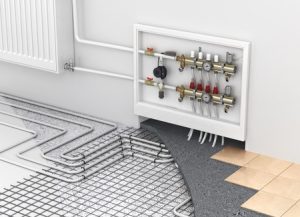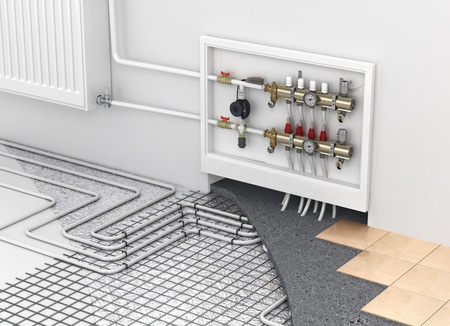 What’s the best heating system you could possibly have? How about one that is invisible? That’s exactly what radiant floor heating has to offer. With both aesthetics and efficiency going for it, radiant heating increases comfort while decreasing energy costs.
What’s the best heating system you could possibly have? How about one that is invisible? That’s exactly what radiant floor heating has to offer. With both aesthetics and efficiency going for it, radiant heating increases comfort while decreasing energy costs.
How does radiant floor heating work?
Warmth is supplied in radiant floor heating by hot-water tubes or electric wires buried under the floor. Invisible waves of thermal radiation rise from below, warming objects they strike; the objects in turn radiate the captured heat. Radiant floor heating relies on convection, or the natural circulation of heat within a room as air warmed by the floor rises.
This is different from a conventional, forced-air heating system, where air blows out of the registers and rises to the top of a room, shedding the heat and dropping back down as it cools. This causes ups and downs in temperature, which does not happen with radiant floor heating because the warm air rises and spreads evenly over the entire floor.
Radiant floor heating works with hot water or electricity. The electricity option uses zigzagging loops of resistance wire fitted to a single room, while hot water systems circulate water from a boiler or water heater through loops of polyethylene tubing. The second option is the most popular and cost effective.
Advantages
According to the US Department of Energy, radiant heating has many advantages. This system eliminates duct losses and does not disturb allergens. Hydronic systems use little electricity and can use a variety of energy sources to heat the water, from standard gas or oil-fired boilers to solar water heaters.
Types of radiant floor heat
Hydronic radiant floors
Hydronic, or liquid, radiant floor heat systems pump heated water from a boiler through tubing laid in a pattern under the floor. Controlling the flow of hot water through each tubing loop using zoning valves or pumps and thermostats regulates room temperatures in some systems.
Electric radiant floors
Electric radiant floor systems use electric cables built into the floor. This system can be cost-effective if it includes a significant thermal mass like a thick concrete floor. Check to see if your utility company offers time-of-use rates, which allows you to charge the concrete floor with heat during peak hours overnight and turn it off to save on cost during the day. If your floor is thick enough, it will stay heated for eight to ten hours without additional electricity.
Energy.gov suggests ceramic tile is the most common and effective material for radiant floor heating because it conducts heat well and adds thermal storage; any covering that insulates the floor from the room will decrease a system’s efficiency. If you want to use carpeting, the site suggests using a thin carpet with dense padding.
Cost
Typically hot water radiant heat costs more to install than other types of heating systems, but once it is up and running, this type of system is 30 percent more efficient than forced-air heating.
Why deal with sudden temperature fluctuations in your home when you can enjoy an even, consistent blank of heat? Keep radiant floor heating in mind as the winter months creep in closer.
Ready to start a home improvement project? Keep Ivy Lea Construction in mind for all of your installation and remodeling needs.

